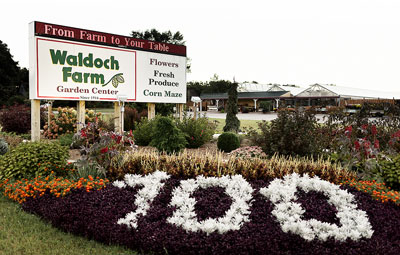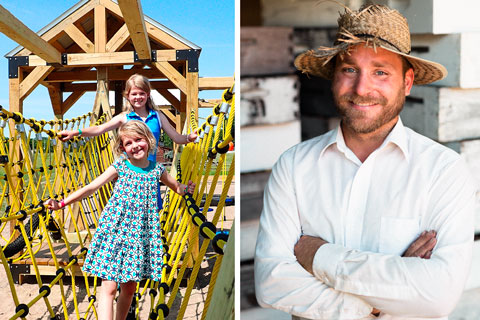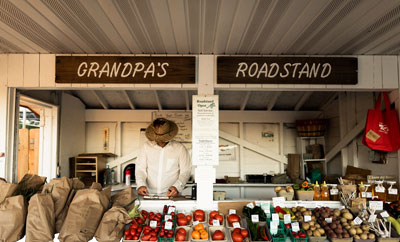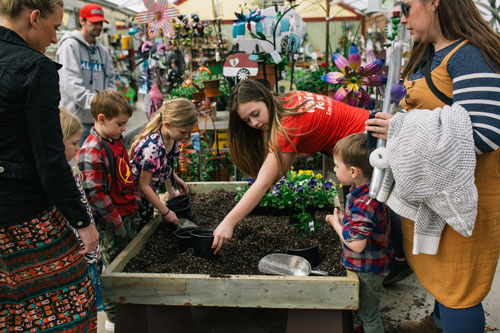4/1/2022
Making a Case for Agritourism
John Kennedy

Doug Joyer is a fourth-generation farmer and family man from Lino Lakes, Minnesota. In 1916, Waldoch Farm began growing produce to sell at the local farmers markets in the Twin Cities area of Minneapolis and St. Paul. As the business continued to evolve over the years, and the population began to expand beyond the city limits, the journey of becoming an agriculture destination began to take root.
“Our vegetable plants were started in the greenhouses, but then transferred to grow in the fields and harvested for the farmers markets and roadside stands that had been built and used since the 1940s,” said Doug.
This approach to growing and selling plants and produce continued from the 1970s through the 1990s, until one day a light bulb went off.
“One day, my mother Mary was emptying the truck after getting back from a long day at the markets and my aunt Kathy was helping someone with a sale that was more than the money brought in by market sales all day,” Doug remembers. “In that moment, my mother made the decision to not go to market the following year. This started the shift in our focus to get customers to come to our farm instead of driving to them at the farmers markets.”
And as they say … the rest is history.
Developing the Model
The 2000s brought a new approach to the Waldoch Farm and Garden Center model, moving from serving the customers to inviting the customer to experience all that farm life had to offer.
“In the mid-2000s, our pick-your-own pumpkin patch was listed on a website next to corn mazes and people came to the farm thinking we had a corn maze. A few years later, my brother Andrew and I both returned to the farm after college (and other jobs in the horticulture industry). We experienced a bumper crop of pumpkins, but didn’t sell all of them. This, combined with the fact that many people already thought we had a corn maze, made it the perfect time for us to begin adding more family fun to the farm. The next year, in 2011, we planted a corn maze and started to charge admission into the farm, all to try and sell more pumpkins—it worked!”
 Pictured: Doug Joyer is the fourth-generation owner of Waldoch Farm in Lino Lakes, Minnesota. The farm dates back to 1916.
Pictured: Doug Joyer is the fourth-generation owner of Waldoch Farm in Lino Lakes, Minnesota. The farm dates back to 1916.
And with that trend, the family invested in building a customer-driven experience that today is starting to catch up to the annual revenue they earn from the plants and garden center sales. Just like Mary and Kathy from way back when.
In 2021, they added The Joyer Adventure Farm Experience “which includes family play areas, our Pumpkin Patch and our Corn Maze.”
The current “mix” is roughly 60% garden center retail sales and 30% agritourism with the balance of categories rounding out their overall offerings.
“Some of the guests who visit for the fun in the fall become garden center customers as well. Flowers at Waldoch Farm and Garden Center continue to be a staple all season,” Doug says. “For example, as we have more guests in the fall, we sell more mums. We now plant six acres of sunflowers to walk through and ‘pick-for-purchase’ … and even sell potted sunflowers in August, too!”
The Boost Agritourism Provides
Doug shares some additional insight as he sees his family’s agritourism business continue to grow to meet the changing needs of his community and customer base.
“We also discovered that people are willing to drive farther for entertainment than they are willing to drive for fresh food or even an excellent garden center,” he notes. “In our experience, people seem to be willing to drive an hour or more for entertainment, about 45 minutes for garden center
products, and about five to 10 miles (maximum) for fresh produce.”
By offering a fun family experience coupled with a successful retail garden center foundation, the magnetic pull begins to expand an existing client base. More customers coming back more often is a magical mix that any business would desire.
Doug’s challenge over the next few years is to have his fall sales match his spring sales (currently his spring sales—May—represent roughly 45% of his total revenue for the year). Doug is looking to have October post the same numbers as May.
 When asked if he had any advice for garden centers that are contemplating the shift to the companion business model of agritourism, Doug suggests the following: “Some of the best advice that I got when we started getting into agritourism was to grow within your means. Don’t over-extend yourself trying to get into it.
When asked if he had any advice for garden centers that are contemplating the shift to the companion business model of agritourism, Doug suggests the following: “Some of the best advice that I got when we started getting into agritourism was to grow within your means. Don’t over-extend yourself trying to get into it.
“Another good thing to look into before making large investments is how agritourism is managed within your local ordinances. You want to make sure that you are going to be able to follow through on what you are planning, both logistically and based on the amount of resources you have. These resources include not just finances, but people, and what your location can handle as well.”
So, as you begin to contemplate how agritourism may add to your existing business offerings, take a tip or two from a fourth-generation farmer who’s one of the leading voices bridging agriculture and tourism: measure twice, cut once!
Doug Joyer is the current treasurer and member of NAFDMA (The International Association of Agritourism), as well as a member of The Garden Center Group. Both associations benchmark their members and share successes, challenges and opportunities. For more information on both associations, visit www.nafdma.com or www.thegardencentergroup.com
 And to visit Doug and his family, go to www.waldochfarm.com or head on over to Lino Lakes … and tell him John sent you!
And to visit Doug and his family, go to www.waldochfarm.com or head on over to Lino Lakes … and tell him John sent you!
Pictured: Events at the farm pull people into the garden center and vice versa. Here, kids pot up plants at a recent open house at the garden center.
John Kennedy is the co-founder of Agritourism.Life and a service provider for The Garden Center Group. He and his wife Souny have created a robust platform that promotes, engages and benchmarks farms, garden centers and wineries in North America. Their magazine, digital solutions and search engine are dedicated to celebrate and accelerate the growing momentum and movement of agritourism world-wide. Visit www.agritourism.life or www.yourfarmspace.com for more information.
In the Next Issue: The next story in this three-part series within a series will spotlight the “Farm to Table” movement within the agritourism and garden center space. My wife, Souny and I traveled to McDonald, Pennsylvania, to experience an amazing evening of food, fun, family and fellowship. Join us next month as I introduce you to Russ and Melanie Bedner and their magical “Farm to Fork” dinner, as well as their winter produce program and ever-expanding enterprise—including wine.
A Series Within a Series
I’m grateful to have been asked to contribute this three-part series in On the Road for Green Profit magazine.
Soothsayer Jennifer Polanz sees what I’ve been seeing for years—an emergence of experience-driven, participative agriculture of tomorrow evolving from a declining interest in the garden centers of yesterday. The bridge that extends from the last 30 years to the next 30 years is being built … accelerated by the pandemic and rapidly changing demographics and desires of a younger
population.
The garden center industry, like many, many others in North America, has shifted dramatically over the last two years. Some for the better … some not so much. Luckily, the horticulture and agriculture industries both benefited from the increased demand and renewed interest in being outside, being surrounded by nature and plants, and centered on family, home and health.
Although the sales numbers reflect two “bumper” years in a row, it ain’t the Boomers who are buoying the bounce! If you dig below the surface, those numbers were actually driven by new, younger, diverse and principle-based feet arriving at the doorsteps of garden centers. And what they’re looking for is not your daddy’s Oldsmobile.
That same generation is also the next generation of leaders, owners and garden center operators who’ll be converting the family Toronado into a futuristic Tesla. Updating digital platforms, offering e-commerce and online purchases, driving social media engagement, and seeing the future of the garden center space … not just the present.
That future is going to be driven by how people shop. Old school shopping was done once or twice a year (consider it a run to Costco in the spring and the fall). These days, the younger conscience consumer is shopping more like a European, headed to the local market on a more frequent basis. Buying fewer things more often.
We may see the average dollar amount they purchase go down, but the frequency of the feet will drive overall sales up in the near future. Adjusting and changing your business plan to meet this transformation will be key to your business success into garden center space of sooner than later. This is why having offerings that flatten the twin peaks, extend the revenue making months and drive relevance to the emerging audience of the green industry is vital. And agritourism checks all three boxes.
For the next three months, we’ll look at three different owners and operators who’ve been nimble enough to change, wise enough to look beyond the horizon, and bold enough to consistently expand and evolve their existing enterprise into the future of the garden center space. They’re combining two cousins separated at birth—agriculture and tourism. GP